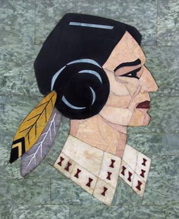TUSCARORA LAPIDARY SOCIETY, INC.
We teach the journey from rocks to gems to jewelry.
COURSE DESCRIPTIONS
Art Clay Silver
Students will learn to make objects of jewelry with a special clay that when fired becomes 99.9% pure silver.
Bead Crochet
Learn to crochet a bracelet or lanyard-type necklace from seed beads in this course. Crochet experience is helpful but not necessary. Patience is a must!
Beadstringing, Beginning
Learn how to knot necklaces and bracelets on silk (with and without clasps) as well as how to make earrings and chain necklaces. The course may include making a bracelet and a necklace with clasps; earrings; an endless strand necklace; a chain necklace, eyeglass holder, or lanyard/badge holder; and a woven bracelet. The instructor supplies handouts for each project, demonstrates how to work with semi-precious stones, pearls, and French wire; gives tips and valuable information about beadstringing; and encourages an exchange of ideas. Appropriate beads, thread, findings, and tools will be available for purchase at class; students also can bring their own supplies.
Beadstringing, Advanced
Prerequisite: Beginning Beadstringing or must know how to knot (you don’t have to be an expert, but you must be able to attach clasps and do knots.) Potential class projects include multi-strand necklaces, necklaces with a single strand at top & double/triple strands at bottom, necklaces with a side or center focal piece, double-drilled beads, watch bands, and repairs. This class is good for exchanging ideas, doing more than straight stringing, and figuring how to make more complicated pieces. It’s a bit more flexible than the more structured beginning beadstringing. There are no handouts in this class and projects are chosen by the students.
Cabochons, Beginning and Intermediate
This course will put you on the road to becoming a lapidary — a person who cuts, polishes, or engraves precious and semiprecious stones. In Beginning Cabochons you’ll learn how to cut and polish oval and rectangular cabochons and how to evaluate your finished project. In addition, you’ll learn how to select cutting material as well as how to use a standard template, a trim saw, and grinding and polishing equipment. Written instructions and material suitable for cutting into a cabochon is provided. Safety goggles and a waterproof apron are required. In Intermediate Cabochons, you’ll learn how to cut and polish other common shapes for cabochon stones including freeform.
Cabochons, Advanced
This ten-week course is offered only to members of TLS. Students in this course work on advanced projects such as free-form designs that have both inside and outside curves. A senior instructor is available to answer questions. Most students taking this course are working on their advanced SKIP (Skill Improvement Program) certification. Students must provide their own cutting material, safety goggles, and a waterproof apron.
Chain Maille
Learn how to make jewelry by linking metal rings of various sizes and colors. With a supply of rings and some basic pliers, one can make bracelets, necklaces, pendants, key chains and more.
Channel Jewelry
Prerequisites: must have taken a cabochon course or equivalent and have taken a silver class or have knowledge of soldering. The art of channel jewelry includes the skills of soldering strips of silver together to outline a picture or figure, as in a line drawing, then soldering it to a silver back. The spaces (or channels) between these silver strips are then filled with accurately cut stones. During the course the student will make one piece of channel. Although having some equipment at home is not necessary, it will help in the timely completion of the project.
Enamel Jewelry
Enamel jewelry is created by fusing powdered glass to metal. There are several special types of enameling including cloisonné and plique-à-jour. In cloisonné, the enamel is placed in small enclosures created by attaching thin flat wire to a metal base. The fine wire serves as a separation between the colors when firing. In plique-à-jour, fine silver is saw-pierced, and the enamel is placed in the openings. As there is no backing, light passes through the enamel giving a stained glass effect.
Faceting
Faceting is the skill of taking a rough piece of clear gemstone and turning it into a stone with many flat planes (facets) suitable for jewelry. In this class, the student will learn how to use a faceting machine that uses precision components as well as angles and degrees of a circle to grind and polish the facets. Suitable cutting material is provided. The student will follow written instructions and go step-by-step with the instructor as a gem is cut. The student can expect to finish one stone during the length of a ten-week course.
Gem/Mineral/Rock Identification
In this course, students will begin to learn the differences among gems and minerals and how to identify them.
Gem Trees
In this class students will learn to form a tree using wire that will then be attached to a decorative base. Small, tumbled pieces of gem stones will then be attached to the branches. Tools needed: Pliers (flat nose, round and regular nose), wire cutter, 527 glue (get at the craft store), ruler, pencil and paper for notes. Wire, tumbled gem stones, and stones for the base of the trees can be purchased at class.
Glass Bead Making
In this class, students will be introduced to making beads out of various colors of Moretti/Effetre glass by working at a torch. The class will include safety instruction, basic bead forming techniques, and various types of surface decoration.
Intarsia
Intarsia is the art of assembling small pieces of stone together to form a whole; similar to mosaic but without spaces between stones. Students learn how to carefully shape the sides of the pieces of stone to form a tight fit and how to glue them together. A solid piece of stone is added to the leveled back, after which the piece is then ground, sanded, and polished to completion.
Opals
This five-week course will help the student to learn the differences between the various types of opal found in the world and to identify those kinds. Many pieces of opal will be on hand to examine and study. The cutting and polishing of opal will also be discussed.
Opal Cutting
This five-week course, or one-day workshop, is specifically focused on cutting opal cabochons. Students learn how to make the most of the opal rough they have, cutting and polishing it to retain as much of the opal as possible.
Silver Jewelry, Beginning
In this class, students will be introduced to the basics of working with silver. They will be guided through one or two projects that use various techniques of cutting, soldering, filing, and polishing. Some finished stones may be incorporated into the finished pieces. Projects will vary in each course. Most equipment and tools are available at the Education Center. Students will be informed if any additional items are needed.
Silver Jewelry, Advanced
This class is for the student who has mastered the beginning techniques of working with silver. Students are encouraged to work on their own with the guidance of the teacher. Some projects may be introduced by the instructor to teach a new skill.
Viking Knit
In this workshop, students will learn a method of wire weaving that can be used to create necklaces or bracelets out of silver or copper wire. The workshop project is typically a copper bracelet. The technique is perfect for home projects, as it requires only a very simple set of tools and easily available supplies. Illustrated instructions and a basic tool are provided.
Wax Modeling
Wax modeling is the first step in using the ancient art form of casting to make metal jewelry. Wax sheets or other wax forms are used to shape jewelry pieces that are then cast in gold, silver, or another metal. In this class, students learn how to use wax modeling tools and how to work with different kinds of wax. While actual casting is not done during class, it is explained and discussed. Students will need to purchase a beginning set of wax carving tools; wax also may be purchased from the instructor.
Wirewrapping, Beginning
Wirewrapping is the art of creating solderless jewelry using wire to set finished stones. Students will learn the basics of wire wrapping, the kind of wire that can be used, and the use of proper pliers. Tools needed: Ruler with inches and centimeters, wire cutters, and pliers (flat nose, regular, and round nose).
Wirewrapping, Advanced
Prerequisite: Beginning Wirewrap. Students will learn new methods of wire wrapping and the use of different gauges and tempers of wire. Build on the basics and learn the use of new tools. Tools needed: Ruler with inches and centimeters, wire cutters, and pliers (flat nose, chain nose, round nose). Wire and additional supplies can be purchased at class.
Follow us on Social Media
Contact us
24 Upland Road
Brookhaven, PA 19015
610-490-5252
email
New to TLS? We'll send several emails each year about upcoming events and classes. Please check spelling before clicking on subscribe!

